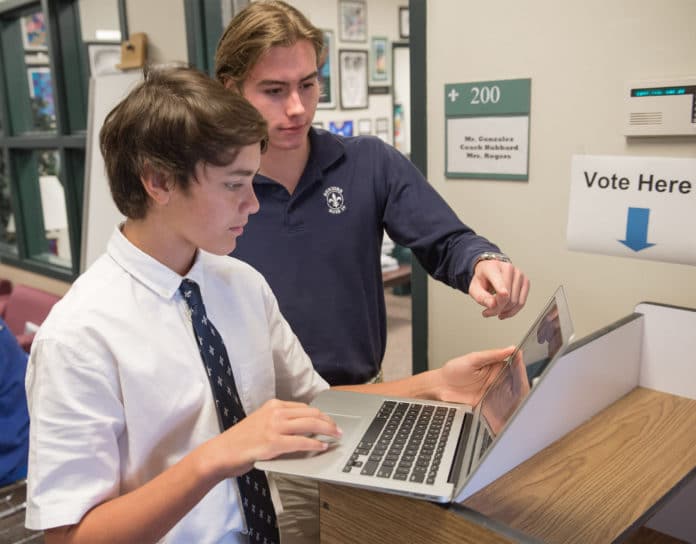More than 100 preschoolers watched wide-eyed on the morning of Nov. 2 as senior Thurman Hogan III used “Donald the Elephant” and “Hillary the Donkey” toys to kick off All Saints’ Episcopal first all-school mock election.
“Red is the elephant’s favorite color and blue is the donkey’s favorite color. So you’ll choose red or blue and give it to the big kids to record on your chart,” said Thurman, an Advanced Placement government senior helping run the election.
Back in their classrooms, the young students chose paper cutout elephants or donkeys and colored them red or blue. The cutouts were placed on a poster board representing votes for Donald Trump and Hillary Clinton.
Teachers entered the early childhood votes – 61 percent for Trump, 39 percent for Clinton – into a computer program where older students cast their own votes.
Some preschoolers used slightly different criteria than elementary, middle and high school students who chose Trump by a two-thirds majority from a ballot that also included third party candidates Libertarian Gary Johnson and Green Party Jill Stein.
Two 4-year-olds chose the blue donkey because “my favorite color is blue,” – Natalie – and “because my mother told me to” – Luke.
The mock election process also emphasized something missing from the actual election process: kindness.
“Our Lower School, and entire school, has the goal of demonstrating kindness in all we do,” said Debra Koppelberger, head of Lower School.
“While a presidential election has opposing candidates and ideals, our focus has been on the perspective that voting is both a right and responsibility. As such, once voting is complete and the candidate is elected, all citizens must support and respect the president, even if your candidate is not elected. Students are also demonstrating kindness through respectful debate and discussion throughout the election process.”
With 82 percent of the college preparatory school’s 1,050 students casting ballots, the unique schoolwide election conceived by veteran teacher Ann Baldwin and carried out by her 50 AP government students was declared a rousing success by school spokeswoman Keira Moody. By comparison, U.S. turnout in the 2012 presidential election was 53.6 percent, according to the Pew Research Center.
“Our curriculum and programming are designed to create a comprehensive journey from the 3-year-olds in Early Childhood all the way up through seniors in high school,” Moody said. “The mock election fits in perfectly with our mission to launch global citizens into the world who can critically think through issues that they’ll face in the future.”
Brianna Vinson, a senior who helped with the early childhood election, agreed.
“Involving kids at such a young age alone makes it unique,” she said. “Even if people think they don’t know what is going on, they really do. It encourages them to think and learn what a privilege it is to vote.”
Pre-election education and voting methods were tailored for the various age groups. Kindergarten through sixth graders came to the library by classes to vote online at computers containing ballots with photos and names of the four presidential candidates.
The seniors, who discussed the meaning and process of U.S. elections at chapel sessions the week before, urged students to research the candidates, political parties and issues for themselves.
Sixth graders Jake Milliken and Will Parrish did that by watching and listening to political news.
“Some of the news is accurate. Some is not,” Jake noted. That’s why Will preferred to “actually listen to the candidates” at televised debates instead of “just going along with” parents and friends.
Seventh through 12th graders were encouraged to cast their votes on their own digital devices between 7 a.m. and 7 p.m. on Nov. 2. Paper ballots were provided to those who didn’t bring laptops or cell phones.
Middle School Head Michael Gonzalez said students were lined up to vote when he arrived early on Nov. 2. By 11:30 a.m., 130 seventh and eighth graders had voted, said Moody, who credited Gonzalez with the final turnout by all 153 middle schoolers.
“The presidential election is like my Super Bowl,” said Gonzalez, whose 93-year-old father is still excited about voting Nov. 8 – more than more than 70 years after he was sworn in as a U.S. citizen while serving in World War II.
Gonzalez, who has held mock elections just for middle school students, is thrilled that the entire school participated this year. He accurately predicted that the schoolwide vote would be more evenly split than his past elections when 90-plus percent voted for Republicans.
“I wanted my students to hear from seniors who will be voting for real this year,” he said. “In a blink of an eye, most of these eighth graders will be voting in the next election. I wanted them to be researching the process.”
Eighth grader Mather Wilson confessed that she found the two presidential debates she watched boring at first but gained valuable information about the issues. “It helped me decide on my own instead of just through my parents,” she said.
Tired of listening to the debate candidates “yelling at each other”, classmate Jack Dixon switched to researching their views on the issues online. “It helped me get more information, especially on the third party candidates,” he said.
Baldwin’s students organized the election and educated students with help from seven digital journalism students who publicized the election and published the results in the online campus newspaper.
At the same time, many were preparing for their own first vote in the “real” Nov. 8 election.
Senior Grace Evans’ parents encouraged her to educate herself and come to her own conclusions rather than blindly following others. She had she was dismayed during the 2012 election to hear classmates “parroting outrageous comments” she believed they picked up from others.
“Now I have a chance to research on my own, I had to choose the one I thought represented me the best on the issues that were most important to me,” she said. “Even if I didn’t like any of the candidates, it’s my responsibility to vote.”
Sean-Michael Pigeon is just as emphatic that voting is a right, a privilege and a responsibility – a message that he and his government classmates have tried to impart to the younger students.
“Even protest voting is still a vote,” he said. “It’s not a wasted vote because you’re telling the next government that none of these candidates represented me. No matter who wins [he or she] needs to fairly represent the people.”
The mock election is not the end of the election road for AP students. For the third presidential election since 2008, Baldwin’s students will spend election night Nov. 8 at the school watching the results roll in.
Regardless who wins, Baldwin and 38 seniors will travel to Washington, D.C., for a week surrounding the inauguration.
“How lucky I am to be in AP government at a time when a real election is going on, to have some unique discussions about history unfolding as it happens,” said Jacob Matthews. “Of course, I’d like to see some candidates more of my choosing on the inaugural stage, but regardless who wins, it will be exciting.”
Baldwin said she has been “hooked” on politics since she helped a high school classmate’s father win an election. For 41 years, she has carried her passion for politics to thousands of students.
“What we’re doing is really a process,” she said. “After a many-months project, we leave Jan. 16 to spend a week watching the events surrounding the peaceful transition of power. The point is not about the person but the peaceful transition of power.”








